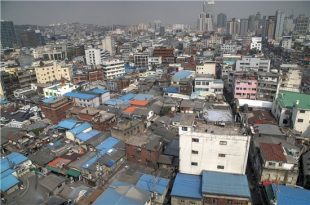Euljiro provides window into Seoul’s industrial past
Euljiro industrial supply market, a sprawling web of sheet-roofed shelters nestled within high-rise buildings in downtown Seoul, has seen better days. “Business is bad. Export orders keep falling because other countries can now manufacture parts on their own,” Jeon Yong-sik, 67, a metal spinning craftsman with 50 years of experience, said at his store last week. “There is no one to pass on my skills to either because young people don’t want to learn this work.” Many shops remain idle after a brief buzz of activity on a Monday morning. A few art students can be spotted at the store entrances, looking for bargains they use to install their term projects. The area has been long marked for redevelopment. Despite the eviction letters and falling business, however, many craftsman and technicians have held their ground.
This made Euljiro, the heart of the country’s industrial development in the 1970s and 80s, a rare window into the country’s modern industrial history. “It’s like an island in the middle of downtown Seoul that is still stuck in the 1970s and 80s,” Christine Lee, a tour guide at Guide Coop, a local cooperative of experienced English-speaking guides, told The Korea Times in a recent tour to Euljiro market. Euljiro is a rising tour spot for visitors who want to experience a more intimate side of the city than just skyscrapers and Joseon era palaces, Lee says. Guide Coop runs regular small group tours in the area for travelers who want to learn about the city’s industrial history and meet face-to-face the local craftsmen. “People used to say you could make tanks and missiles here. ‘Made in Euljiro’ was common slang in those times,” Lee said, waving her hand at the dilapidated store fronts and dust-coated piles of metal parts inside a small alley. “Even now, it’s an outdoor market for materials and craftsmanship talent, a place where you can create anything from scratch _ from buying the raw materials to taking the product to completion,” Lee added. “Industrial designers who visit from abroad tell me it is impossible to find such production infrastructure in the middle of the city in any other metropolis.”
Cha Kang-soo, who set up his shop in Euljiro 38 years ago, has gone from fixing radio sets to becoming a well-known inventor. “I’ve tried to adapt with the changing times, and recently cooperated with a young person to work on an artificial intelligence project,” Cha said, before showing off one of his recent inventions -a 10 centimeter-long machine replicating the motions of an erupting volcano. “An overseas customer ordered it to make an interactive globe,” he said. Shops here, having been around for more than 50 years, have interesting resumes, including one that made the 3D contour camera used by Yi So-yeon, Korea’s first astronaut, to measure her physical changes. Japanese craftsmen populated the area during the 1910-45 colonial rule era and many shops still use Japanese terms like sibori, Japanese for “metal spinning,” on their signs.
The part of the neighborhood that is closer to Euljiro 3-ga Station is full of “dabangs,” old-fashioned cafes serving instant mix drinks, and numerous beef barbeque restaurants _ remnants of the more prosperous past when the craftsman were making good money. Jeon, the master metal spinner, says the rent is not climbing despite the area’s location in the middle of downtown Seoul. He pays about 600,000 won per month for his 33-square-meter shop inside a small alley. “The rent has actually started falling beginning two years ago,” he said with a shrug. “Because many shops are empty.”
By Lee Suh-yoon
(Korea Times)






















































